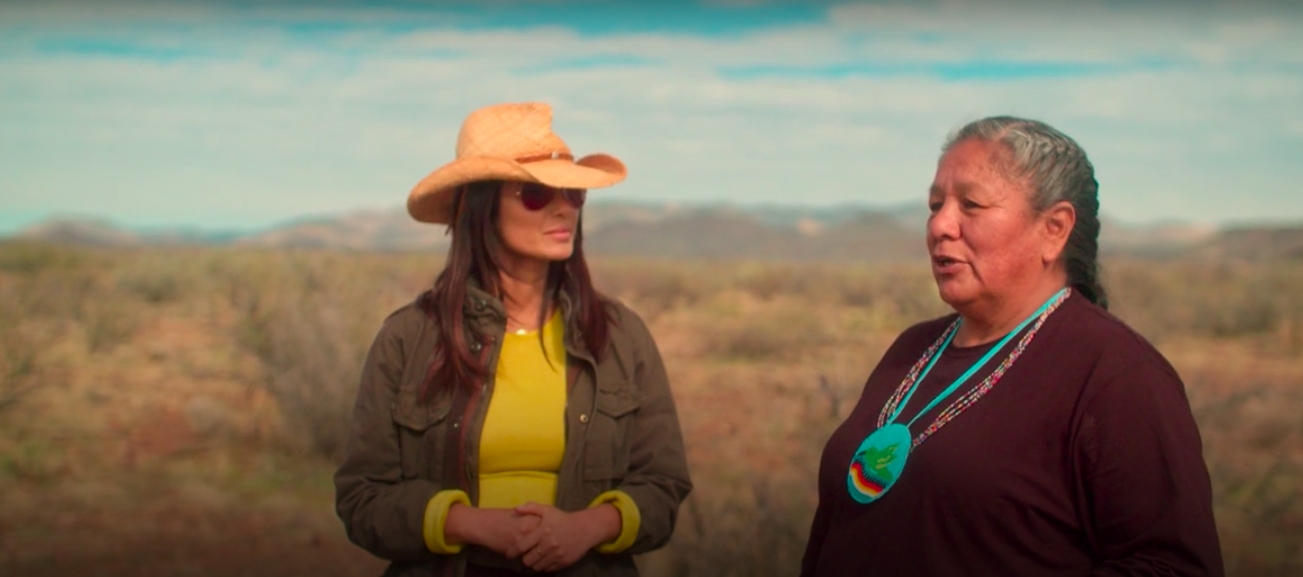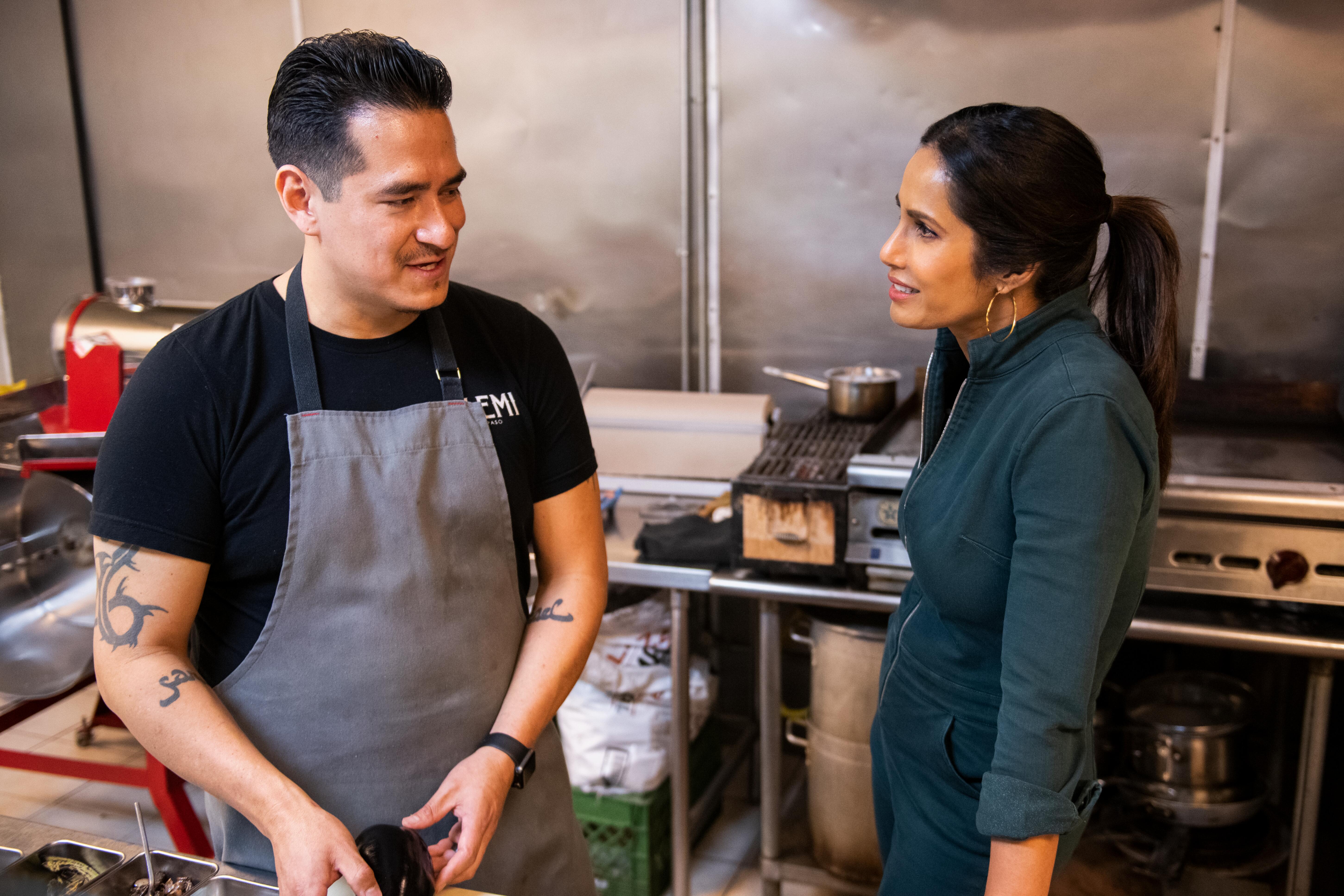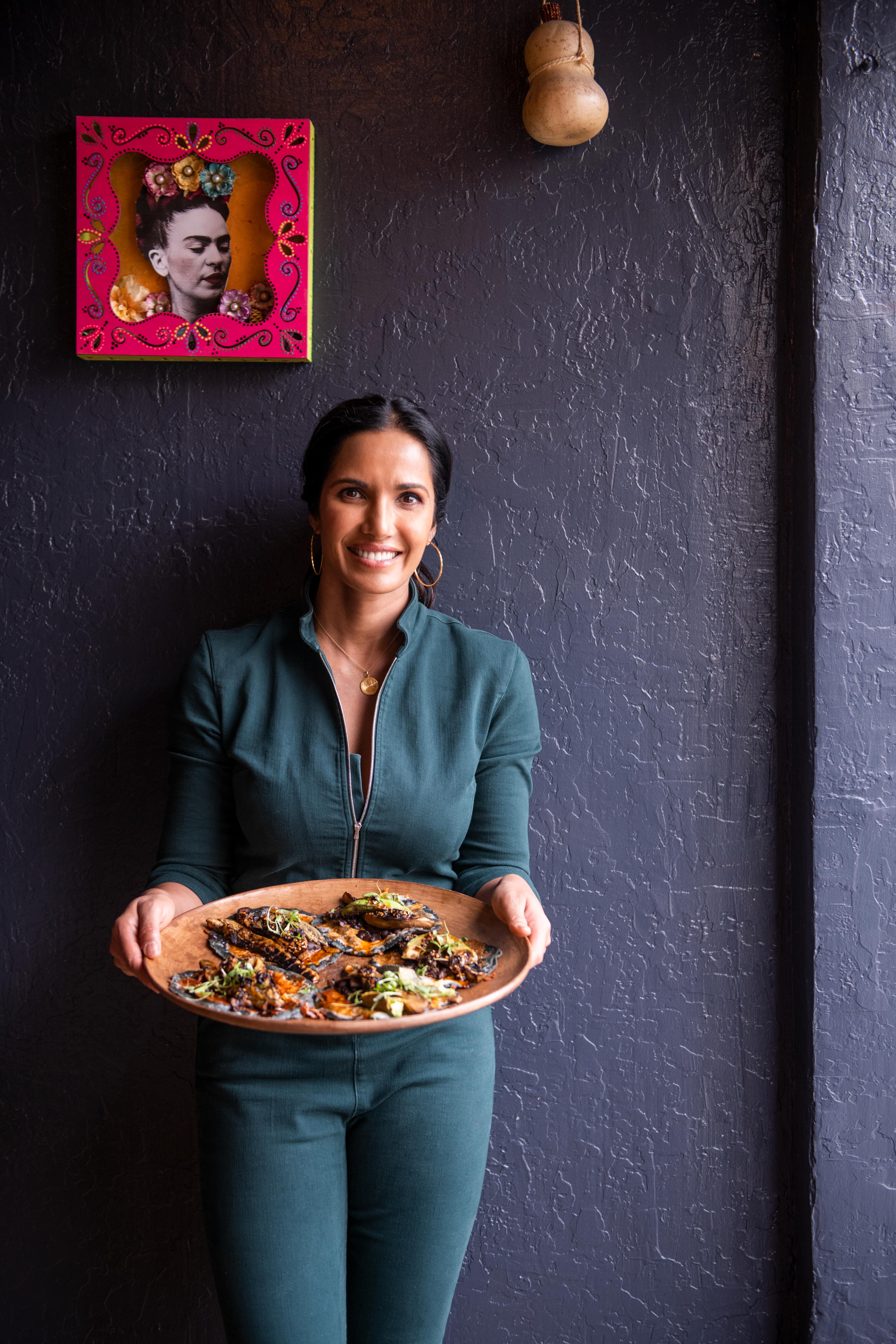Top Chef co-host Padma Lakshmi has managed the impossible. She’s made food and travel TV relevant again. Taste the Nation (my review) doesn’t bombard you with huge doses of food porn from chic restaurants most of us will never get to go to. Instead, Lakshmi and her team venture deep into the American psyche by digging into both the Indigenous and migrant communities that make up the cultural fabric of this country.
In the process, the show manages to strike a harmonious balance between being thought-provoking and educational while also offering a sense of escapism and wonder. In short, Taste the Nation is exactly the food show America needs right now.
As an immigrant, Lakshmi makes an ideal host for a show centered on immigrant food, which is to say: pretty much the majority of mainstream “American” food, from hot dogs to apple pie to pizza to gumbo and beyond. But the show goes well past these commonly explored dishes by paying homage to Indigenous food culture in a way that’s rarely seen on mainstream TV. That aspect is what Padma and I met up (over the phone) this week to talk about.
As Lakshmi and I discussed food history, the importance of representation in food TV, and how adaptation and evolution make our shared foodway great, her team informed me that we’d run out of time. She was generous enough to extend the conversation in a follow-up call and I’ve included both parts below. Check it out and then watch the full “The Gullah Way” episode below.
So let’s first talk about the show. It feels very unique; very creative. It’s a bit of an outlier, even in the world of food and travel television. Where did the idea for this show come from?
It came from my work as an artist ambassador with the ACLU — the American Civil Liberties Union — on immigration issues. Shortly after the 2016 election, I started getting involved with them. And as an immigrant myself, I felt really offended by a lot of the rhetoric coming out of Washington that, in my opinion, vilified immigrant communities and the contributions that they have made over generations to this nation.
So, it was through my work on the issue that I felt compelled to write a cookbook celebrating all the foods that immigrants had brought here. And then, in tandem, I was working on a TV project on immigration. My producing partner saw the research that I was doing for the cookbook and we melded the two ideas together. It’s been a real joy to see something that was just an idea in your head turn into a full-blown series.
I’m very lucky that I got to do it.
I come from an Indigenous background and full disclosure, you’ve actually judged one of my Indigenous dishes before for UPROXX. I made a blue corn tamale stuffed with blueberry and Juniper.
That sounds good. Did I like it?
You did! Because of that, the first episode I watched was the one with the Indigenous chefs. It touched my heart because when you’re with Felicia Ruiz, you ask her the same thing you asked me, “How do you know what’s safe to eat when you forage?” It’s really fascinating to watch these Indigenous ingredients get a moment in the spotlight.
How was the decision to include Indigenous food in the show made?
Well, I thought that if I was going to explore “American food” and be truthful about that, I needed to give credit where credit was due. That’s what the whole ethos of the series is. It’s to let people from different communities speak for themselves and create their own narratives — which has not been the case in mainstream media, in my opinion.
So I had to start at what was truly, natively American food before the colonial forces came in and before the European settlers came in and before Christopher Columbus. Depending on the region you’re living in, three sisters is what was in this country, right? Corn, squash, beans. So, I was really interested in embedding myself in a Native American community.
While I’m an immigrant, I’ve done most of my schooling in America. And I was appalled at how little instruction I was given on this part of our land’s history. So it was important for me to set the groundwork and say, “Well, this is what actual American food is and has been.” Everything else that we now consider American food was brought here by other people.
Precisely.
And the whole series proceeds to delve into different communities and what those foods are, but I felt I had a responsibility. Even from an intellectual point of view, I just wanted to learn what I had felt I was deprived of knowing because of a lack of representation in history books. So that’s why I went to San Carlos. That’s why I went to talk to Felicia and the people who are in that episode.
It was really, for me, one of the most eyeopening experiences I’ve ever had. I’ve never foraged for my own food. I’ve never eaten a rodent. I’ve never been on a reservation. It was really a learning episode for me and one that I hadn’t seen in food television. It’s a story that I wanted to let that community tell on as big of a platform as I could give them.
I teared up watching that last scene around the table. My dad’s from a reservation in the Pacific Northwest. And when I got into this business of writing about food, I did so because I wanted to highlight Indigenous food and Indigenous chefs. So seeing Indigenous chefs and food given their due on your show was … it feels like a big moment for American food, in general.
Thank you. From your lips to viewers’ ears, I hope that this show catches on because it was such a beautiful journey that I was fortunate enough to take. And I hope that I can take people watching the show on it vicariously, but I’d also like to keep going because there’s so much more to know and learn.

That’s what I was thinking, as well. As I said, I’m from the Pacific Northwest, our foodways have almost no parallels to the American Southwest. It’s like the difference between Norway and Iran, it’s just a different thing.
Yeah! And that’s the thing, we paint each other with these really broad brushes and obviously the food is going to be different in the Pacific Northwest to Arizona or Florida and so on. In a ten-part series, I have so much to cover. That’s why I hope I get another season greenlit because I want the privilege of exploring those differences in different Indigenous communities.
When you were trying the Indigenous foods down there, did you find any parallels in tastes or textures that were already familiar to you? Was there a connection?
Sure. For me, I really connected with the sumac because I’ve used a lot of sumac from my exposure to Middle Eastern cuisine. And it’s funny because when I was writing the Encyclopedia of Spices and Herbs, I found out that Native Americans used sumac, that it grows wild everywhere in America. So sumac was a taste that I identified with. Then, obviously, the wild onions, and the chilies.
If you see the stone that I’m grinding the chilies with at Felicia’s home, I used to do a very similar thing with my grandmother. So I felt right at home doing that with her. And how we used the chilies reminded me of a lot of different chutneys that my family has traditionally made.
It’s really interesting because the Indigenous side of the series seeps into most episodes, especially the El Paso one. You have this great segment where you take the time to talk about Indigenous Mexican cuisine. How did you navigate that for the show?
I try to approach my work holistically because often the truth is layered and complicated. So in order to get a full understanding of the subject matter that you’re investigating, you need to account for those overlaps.
I can remember having a conversation around some table with other food people saying things like, “No, no, no, if it’s taquitos, you use corn tortillas, but if it’s flauta, you use a flour tortilla.” And this was a table of food professionals and not one person mentioned that flour is a colonial addition to North America and that’s why you have flour tortillas. That it was brought by the Spanish. Traditionally corn is the grain of choice. But that’s why you have both corn and flour tortillas.
To me, that was really interesting. And that has to do with history and colonialism and the layers of how all of those cultures have combined to build into what is now understood as “Mexican” food.
Right.
More specifically, Mexican food to me is super interesting. In America, I think, we are very familiar with Northern Mexican foods because that’s what’s close to the border.
We didn’t have time to go into this, because it was a show about Mexicans in El Paso, but I traveled extensively in Mexico and I filmed extensively in different parts of Mexico as well. We’ve done actually more than one finale for Top Chef in Mexico. And I’ve also gone on my own time with my family. And the cuisine of Mexico is so sophisticated and so diverse. But I don’t think Americans have really scratched the surface of all that is.
It also reminds me of a lot of Indian cuisine with the recados and the seeds. That’s not really surprising when you look at the climate of South Asia and Central or South America. So you have a lot of the same ingredients. You have tamarinds, mango, cumin, coconut, chilies — which are Mexican but were brought to India, again by colonialists. Today you couldn’t imagine Indian food without chili.
Indian food did not have chilies because all chilies come from Mexico and people just don’t know that. I think it’s important because you can trace a country or culture’s history through the foods that they eat. You know, there’s a reason why cumin is in Mexico. It’s because it was brought to Spain by the Moors, which also brought pomegranates. This is why the city of Grenada is called Grenada because that’s the Spanish word for pomegranates. To me, all of that history is really fascinating. And I hope that other people think so too.
You are speaking my language right now. There’s a joke in the Indigenous community that’s basically, “Imagine Italy without the tomato. Imagine Thailand without chili. Imagine Ireland without the potato.”
Right, exactly.

While you were traveling around the country and embedding yourself in immigrant communities, did you get a better sense of what we “think” America is compared to what it is on the ground for migrants?
That’s really what the show is seeking to do. It’s seeking to be a rebuttal to a lot of the vilification and negativity that immigrants have suffered. It’s insulting and offensive to me. I was incensed enough to want to make it my work. Not just my advocacy work, but by actual work-work, my day job.
I think that migration is responsible for a lot of the most beautiful things about humankind. At no other time in our history, as a civilization, has there been more movement, more migration on this earth. This is a subject that deeply interests me because I think that is where the interesting community comes from. Even though there’s a lot of pain, blood, and plunder associated with this, the only good that can come from that suffering — all that pain of earlier times — is the sifting through it all, finding the good, and enjoying it.
So while it sucks that the French were in Vietnam, we wouldn’t have banh mi otherwise. It sucks that people were so interested in spices that they took a left turn when they should have taken a right. Still, it’s cool that India has chilis now. I think that there’s power in the pain that we have collectively gone through as a society. And if we are willing to look with open eyes, we can sift through our collective cultural rubble and at least enjoy the fruits of that very difficult and tumultuous part of our shared history.
I think you don’t get to own only the good things about your culture. You have to be willing to understand that some of those good things come from very dark, bad things.
I feel that.
A lot of the work that I’m trying to do, without hopefully being heavy-handed in the series, is to say, “Okay, nobody comes to a country and leaves everything they know unless they have to or unless there’s a need for it.” Whether it’s forced migration during the Trail of Tears or bringing in slaves from Africa or Iranians or Syrians fleeing the fundamentalist regimes, or… pick any group — that’s what creates migration.
But to me what’s most beautiful is the commingling of our cultures, of sharing, of breaking bread with each other and saying, “Well, I have noodles, I’ll bring that.” And someone else is saying, “Okay, I’ll bring my curry.” To me, that’s something valuable, precious, and worth acknowledging and celebrating.
When my mom came to this country, she was working and she couldn’t find a lot of Indian groceries that she needed. So we have a South Indian dish called upma. It’s made with cracked wheat that’s sauteed with vegetables and spices. It kind of resembles stuffing. And my mom could not find rava or suji, which is the kind of cracked wheat it is, so she used Cream of Wheat because that’s what was affordable and accessible to her at the American supermarket.
Then when I was younger and I wrote my first cookbook I made it with couscous. And then today, because I discovered quinoa, I’d make it for my child with quinoa. Now, is that authentic? Well, it’s pretty damn authentic to me and my life. But it’s interesting that I am using an ancient South American grain to make a very classic South Indian recipe that’s very homey to nourish my family. To me, those are the gifts and the precious stones that dropped out of some very, very dark parts of our history.








